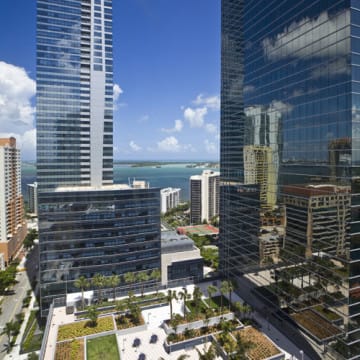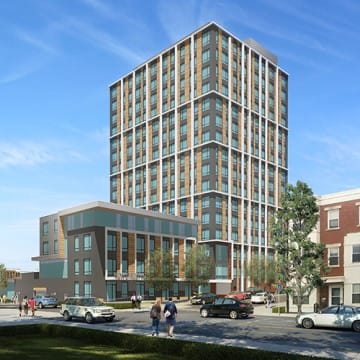FORTIFIED Home Building Standards
In Alabama, hurricanes such as Ivan in 2004 and Katrina in 2005 left devastation in their wake, including homes destroyed that required billions of dollars to rebuild, as well as limited availability of and increased rates for home insurance. Since then, Alabama has been active in encouraging resilience through legislation and incentives.
One example is incentives that encourage the use of FORTIFIED Home™, a set of performance-based engineering and building standards designed to help strengthen new and existing homes through the installation of specific building upgrades that reduce damage from hurricanes, hailstorms, low-level tornados, and severe thunderstorms.
The Alabama Legislature has required insurers to offer discounts to owners of homes meeting the FORTIFIED standards, which have been proven to offer protection against wind damage. Metrics from a recent study by the Alabama Center for Insurance Information and Research (ACIIR) show additional returns on resilience: homes built to the FORTIFIED standards in two coastal Alabama counties earned a nearly 7 percent premium in resale value over those not meeting the standards.
“FORTIFIED standards [are] an economically sound investment. The additional cost of building or retrofitting is frequently less than 7 percent of home value; therefore, the benefit of FORTIFIED designation is very likely to outweigh the cost.’’—Estimating the Effect of FORTIFIED Home™ Construction on Home Resale Value
The FORTIFIED Home program was created by the Tampa, Florida–based Insurance Institute for Business & Home Safety (IBHS), an independent research and communications nonprofit organization supported by insurers and reinsurers, to promote construction and upgrading of homes for resilience to natural disasters. IBHS tests a variety of construction and retrofitting methods at its Research Center in Richburg, South Carolina, running simulations for rain, hail, wildfire, and wind speeds up to 130 miles per hour.
Licensed professionals certify homes at one of three FORTIFIED levels: Bronze, Silver, or Gold. The Bronze level focuses on roof strength and resistance to wind. Silver requires reinforcement of the roof, adding use of impact-resistant windows and doors. Gold addresses the first two levels and further requires a “continuous load path,” ensuring that buildings are adequately load-bearing and secured to the ground. Another set of FORTIFIED standards is used to protect commercial buildings and ensure continuity of operations despite hurricane, high wind, and hail.
As of November 2016, builders and owners of about 6,000 homes had applied for FORTIFIED designation, and 3,600 had been so designated across the United States, most located in the Southeast. A range of homebuilders are building to the FORTIFIED standard, including volume, custom, and modular builders.
“Resilience should be affordable for everyone,” says Julie Rochman, IBHS president and chief executive officer. “It should not just be for high-end custom builders.” FORTIFIED homes are “overwhelmingly clustered in places with financial incentives or some sort of mandate,” such as Alabama, Mississippi, North Carolina, and South Carolina, she says. Builders of new homes strive for Gold designation, she notes, whereas retrofits tend to be designated at the Bronze level.
FORTIFIED standards provide “greater assurance for homeowners that, if an extreme event occurs, they won’t have to move out for six months while they rebuild.”—ACIIR director Lars Powell
Alabama leads the nation with more than 2,500 FORTIFIED homes, and has a variety of programs incentivizing use of the standard. A 2009 Alabama law requires insurers to provide homeowners with discounts for coastal houses that are built, rebuilt, or retrofitted according to FORTIFIED standards. They now earn a discount of about 35 percent on the wind portion of their insurance premium. A state program, Strengthen Alabama Homes, provides grants for retrofitting homes to FORTIFIED standards. The “coastal code supplement” building code overlay adopted by many municipalities is also based on the FORTIFIED standard.
The FORTIFIED standard is becoming better known regionally and nationwide. For instance:
- More than 60 chapters of Habitat for Humanity are committed to using FORTIFIED through the organization’s Habitat Strong program. The organization has tested the standard at various home price points and now builds all coastal Alabama and Mississippi homes to the FORTIFIED standard.
- The White House Forum on Smart Finance for Disaster Resilience in 2016 highlighted the FORTIFIED standard as an example of innovation that helps reduce the loss of life and property, and which can generate value for homeowners.
- Several federal agencies, including the Federal Emergency Management Agency, Department of Housing and Urban Development, Department of Energy, Department of Agriculture, Department of Homeland Security, and Department of Veterans Affairs, have specifically encouraged and recognized the value of FORTIFIED standards through various activities targeting stakeholders in the built environment.
Mitigating Risks
Research is demonstrating the positive impact the FORTIFIED designation has on home resale value, which could help homeowners, insurance companies, and policy makers adopt and promote resilient construction practices.
The study by ACIIR, a research center at the University of Alabama’s Culverhouse College of Commerce, examined data on the resale of homes built to the FORTIFIED standards in Mobile and Baldwin counties. Researchers studied the two Alabama counties because they have direct coastal exposure to hurricanes and the highest concentration of FORTIFIED homes in the country—a circumstance resulting from county building codes that incorporate FORTIFIED standards and insurance incentives that encourage their use.
The study, “Estimating the Effect of FORTIFIED Home™ Construction on Home Resale Value,” investigated the sales of 321 homes from 2004 to 2015, 22 percent of which were built or retrofitted according to FORTIFIED standards.
The homes were located slightly less than two miles from the coast and included residences representing the full range of the market, which has been developing rapidly in recent years with vacation and retirement homes. The houses in the sample on average were six years old and had 2,531 square feet of space on a half-acre lot, four bedrooms and two bathrooms, and a sales price of $293,000. Most of the properties in the sample had been sold within the previous three years.
Researchers used a hedonic regression model to estimate the marginal effect of FORTIFIED home construction standards on home resale value while controlling for other housing characteristics, such as lot size, building square footage, age, number of rooms and full bathrooms, fireplaces (an indication of higher-end construction), distance from the coast, and market conditions when the house was sold.
Creating Value
The study concludes: “switching from a conventional construction standard to a FORTIFIED designation increases the value of a home by nearly 7 percent, holding all other variables constant.” The findings “suggest that building FORTIFIED houses or retrofitting houses to meet FORTIFIED standards is an economically sound investment,” the report says.“The additional cost of building or retrofitting is frequently less than 7 percent of home value; therefore, the benefit of FORTIFIED designation is very likely to outweigh the cost.”
The cost of compliance with FORTIFIED standards for new homes ranges from zero to 3 percent of hard costs, according to IBHS. Building to FORTIFIED standards in jurisdictions with stricter building codes typically means that there are fewer additional costs above those for building to code, except for designation inspection and paperwork. Retrofits generally cost 18 to 24 cents per square foot.
The study shows there is a “value benefit for this type of standard being adopted” in the coastal Alabama market, says a principal researcher, Harris Hollans, associate professor of real estate at Auburn University.
In choosing between two side-by-side houses in the same subdivision, he says, homebuyers would likely find greater value in the FORTIFIED home, which is structurally more resilient and, as a result, earns a reduced insurance premium. The higher resale value is another significant reason to choose a FORTIFIED home. As the FORTIFIED standard is adopted increasingly elsewhere, says Hollans, “there’s a pretty compelling argument to be made that this would likely hold true for other parts of the country that face similar [risks].”
Yet another designation value is “greater assurance for homeowners that, if an extreme event occurs, they won’t have to move out for six months while they rebuild,” says ACIIR director Lars Powell, another principal researcher, who sees ACIIR’s research as potentially transformative for homebuyers. He notes an even greater impact would come from acceptance of the study data by mortgage appraisers, with lenders such as Freddie Mac accepting the information as a valuation factor. “That is what will make it really affect home value,” he says.

